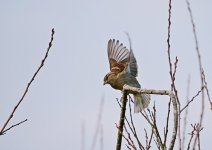- Messages
- 2,529
- Name
- Keith
- Edit My Images
- Yes
I'm beginning to think I am not using enough shutter speed on small birds.
I have been trying the pre-burst mode to capture small birds taking off, where the Pana G9 gives you 0.4 seconds of frames before you hit the shutter.
At first I thought the focussing was failing to catch the moving bird, but now I think maybe my shutter speed is too slow.
I took this at 1/1300 and the face was pretty sharp but the wings still blurred.
Do I need faster speeds for little birds that dart off the branches and have a fast wing speed?
I had to sharpen this, and the light was poor too. Maybe small birds need 1/2000?

I have been trying the pre-burst mode to capture small birds taking off, where the Pana G9 gives you 0.4 seconds of frames before you hit the shutter.
At first I thought the focussing was failing to catch the moving bird, but now I think maybe my shutter speed is too slow.
I took this at 1/1300 and the face was pretty sharp but the wings still blurred.
Do I need faster speeds for little birds that dart off the branches and have a fast wing speed?
I had to sharpen this, and the light was poor too. Maybe small birds need 1/2000?

Last edited:
